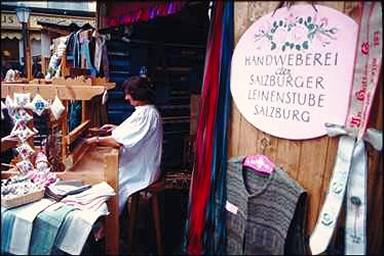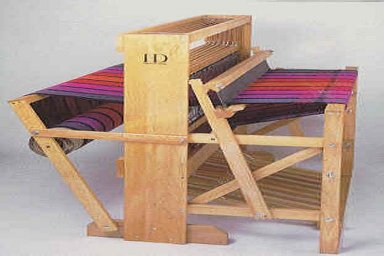Fiber Spinning

Spinning is the twisting together of fibers to form yarn (or thread, rope, or cable). Earlier fiber was spun by hand using simple tools like spindle and distaff. Later the use of spinning wheel gained importance. Industrial spinning started in the 18th century with the beginning of the Industrial Revolution. Hand-spinning remains a popular handicraft.
Industrial spinningFibers can not be used to make clothes in their raw form. For this purpose, they must be converted into yarns. The process used for yarn formation is spinning. Spinning by hand was a slow and laborious process. Thus, Many implements and methods were invented for making it faster and simple. Eventually, the techniques were refined and industrial spinning started manufacturing yarn in various ways. The methods selected depend upon the factors such as the manufacturer's preference of equipment, the economic implications, the
fibers to be used and the desired properties of yarn to be produced. Ring method is the oldest and the most used technique. Open- end spinning is another important method. The basic manufacturing process of spinning includes carding, combing, drafting, twisting and winding. As the fibers pass through these processes, they are successively formed into lap, sliver, roving and finally yarn. A brief description of the journey from fibers to yarns will help in understanding industrial spinning in a better way.

The raw fiber arrives at a spinning mill as compressed mass which goes through the processes of blending, opening and cleaning. Blending is done to obtain uniformity of fiber quality. Opening is done to loosen the hard lumps of fiber and disentangle them. Cleaning is required to remove the trash such as dirt, leaves, burrs and any remaining seeds. Carding is the initial straightening process which puts the fiber into a parallel lengthwise alignment. This makes the tangled mass of fiber ready to produce yarn. Now the fiber is called 'Lap' . The lap is treated for removing the remaining trash, disentangling and molding it into a round rope like mass called 'Sliver'. The sliver is then straighten again which is called Combing. In it, fine-toothed combs continue straightening the fibers until they are arranged in such a parallel manner that the short fibers are completely separated from the longer fibers. This procedure is not required for man made staple fiber because they are cut into predetermined uniform lengths. This process forms a 'comb sliver' made of the longest fibers. The combing process is identified with better quality because long staple yarn produces stronger, smoother and more serviceable fabrics.
Drawing pulls the staple lengthwise over each other. As a result longer and thinner slivers are produced. After several stages of drawing out, the sliver is passed to the spindles where it is given its first twist and is then wound on bobbins. 'Roving' is the final product of the several drawing-out operations. It is the preparatory stage for the final insertion of twist. Till now, enough twist is given for holding the fibers together but it has no tensile strength. It can break apart easily with a slight pull. The roving, on bobbins, is placed in the spinning frame, where it passes through several sets of rollers running at high speed and finally the 'Yarn' is produced of the sizes desired.
Spinning Machines Traditional v/s Modern TechniquesHand spinning was replaced by powered
spinning machines which was very fast. Initially it was done by water or steam power and then by electricity. The spinning jenny, a multi-spool spinning wheel significantly reduced the amount of work required to produce yarn. A single worker was now able to work eight or more spools at a time.

Then came the spinning frame which produced a stronger thread than the spinning jenny. As it was too large to be operated by hand, a spinning frame powered by a waterwheel was invented. It was then called the water frame. The elements of the spinning jenny and water frame were combined to create the spinning mule.
Then came the spinning frame which produced a stronger thread than the spinning jenny. As it was too large to be operated by hand, a spinning frame powered by a waterwheel was invented. It was then called the water frame. The elements of the spinning jenny and water frame were combined to create the spinning mule.

 Ex. 3. Terra cotta vase; Greek, 560 B.C.E.
Ex. 3. Terra cotta vase; Greek, 560 B.C.E. Ex. 1. Funerary model of a weaver's workshop. Egypt, 19th century B.C.E.
Ex. 1. Funerary model of a weaver's workshop. Egypt, 19th century B.C.E. Ex. 2, Neolithic pottery with weave imprint, found in the Thames near Mortlake; from the British Museum.
Ex. 2, Neolithic pottery with weave imprint, found in the Thames near Mortlake; from the British Museum. 







 Spinning is the twisting together of fibers to form yarn (or thread, rope, or cable). Earlier fiber was spun by hand using simple tools like spindle and distaff. Later the use of spinning wheel gained importance. Industrial spinning started in the 18th century with the beginning of the Industrial Revolution. Hand-spinning remains a popular handicraft.
Spinning is the twisting together of fibers to form yarn (or thread, rope, or cable). Earlier fiber was spun by hand using simple tools like spindle and distaff. Later the use of spinning wheel gained importance. Industrial spinning started in the 18th century with the beginning of the Industrial Revolution. Hand-spinning remains a popular handicraft. The raw fiber arrives at a spinning mill as compressed mass which goes through the processes of blending, opening and cleaning. Blending is done to obtain uniformity of fiber quality. Opening is done to loosen the hard lumps of fiber and disentangle them. Cleaning is required to remove the trash such as dirt, leaves, burrs and any remaining seeds. Carding is the initial straightening process which puts the fiber into a parallel lengthwise alignment. This makes the tangled mass of fiber ready to produce yarn. Now the fiber is called 'Lap' . The lap is treated for removing the remaining trash, disentangling and molding it into a round rope like mass called 'Sliver'. The sliver is then straighten again which is called Combing. In it, fine-toothed combs continue straightening the fibers until they are arranged in such a parallel manner that the short fibers are completely separated from the longer fibers. This procedure is not required for man made staple fiber because they are cut into predetermined uniform lengths. This process forms a 'comb sliver' made of the longest fibers. The combing process is identified with better quality because long staple yarn produces stronger, smoother and more serviceable fabrics.
The raw fiber arrives at a spinning mill as compressed mass which goes through the processes of blending, opening and cleaning. Blending is done to obtain uniformity of fiber quality. Opening is done to loosen the hard lumps of fiber and disentangle them. Cleaning is required to remove the trash such as dirt, leaves, burrs and any remaining seeds. Carding is the initial straightening process which puts the fiber into a parallel lengthwise alignment. This makes the tangled mass of fiber ready to produce yarn. Now the fiber is called 'Lap' . The lap is treated for removing the remaining trash, disentangling and molding it into a round rope like mass called 'Sliver'. The sliver is then straighten again which is called Combing. In it, fine-toothed combs continue straightening the fibers until they are arranged in such a parallel manner that the short fibers are completely separated from the longer fibers. This procedure is not required for man made staple fiber because they are cut into predetermined uniform lengths. This process forms a 'comb sliver' made of the longest fibers. The combing process is identified with better quality because long staple yarn produces stronger, smoother and more serviceable fabrics. Then came the spinning frame which produced a stronger thread than the spinning jenny. As it was too large to be operated by hand, a spinning frame powered by a waterwheel was invented. It was then called the water frame. The elements of the spinning jenny and water frame were combined to create the spinning mule.
Then came the spinning frame which produced a stronger thread than the spinning jenny. As it was too large to be operated by hand, a spinning frame powered by a waterwheel was invented. It was then called the water frame. The elements of the spinning jenny and water frame were combined to create the spinning mule.

